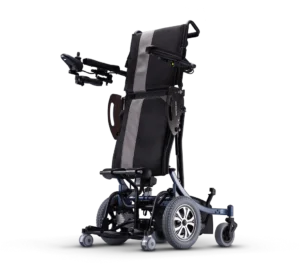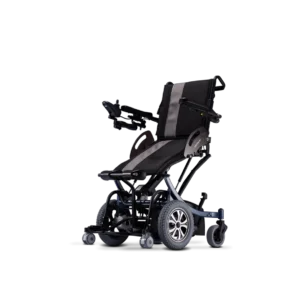Standing wheelchairs have emerged as a transformative solution in the mobility aid sector, particularly in India, where accessibility and independence are paramount for individuals with physical disabilities. These innovative devices allow users to transition from seated to standing, offering numerous physical and psychological benefits. In a country like India, where infrastructure and accessibility are evolving, standing wheelchairs play a crucial role in enhancing the quality of life for many individuals. This article explores the various aspects of standing wheelchairs, including their types, benefits, challenges, and prospects in the Indian context.
Types and Categories of Standing Wheelchairs
Standing wheelchairs can be broadly classified into three main categories, each catering to different needs and preferences:
Electric Standing Wheelchair
Electric standing wheelchairs are powered by batteries and equipped with motors, allowing users to easily switch between sitting and standing positions at the touch of a button. These wheelchairs often come with advanced features such as joystick controls, adjustable seat height, and programmable settings. They are ideal for individuals who require frequent position changes or lack the upper body strength to adjust their position manually.
Manual Standing Wheelchair
Manual standing wheelchairs require the user to manually operate a lever or mechanism to transition between sitting and standing. These models are typically more affordable and lightweight compared to their electric counterparts. They are suitable for users who have sufficient upper body strength and prefer a more hands-on approach to mobility.
Hybrid Models
Hybrid standing wheelchairs combine elements of both manual and electric models, offering users the flexibility to choose between powered and manual operation. These wheelchairs provide a balanced solution for users who want the convenience of electric power with the option to manually control their mobility when needed.



Symptoms and Signs Addressed by Standing Wheelchairs
Standing wheelchairs are designed to address a range of physical disabilities and mobility challenges. They are particularly beneficial for individuals experiencing:
- Physical Disabilities: Conditions such as paraplegia, quadriplegia, and cerebral palsy can significantly impair mobility, making standing wheelchairs an essential tool for enhancing independence and mobility.
- Mobility Challenges: Individuals with limited mobility due to arthritis, muscular dystrophy, or other conditions can benefit from the enhanced movement and accessibility provided by standing wheelchairs.
- Postural Issues: Standing wheelchairs help users maintain better posture and prevent complications associated with prolonged sitting, such as pressure sores and muscle atrophy.
Causes and Risk Factors Necessitating Standing Wheelchairs
Several factors contribute to the need for standing wheelchairs, including:
- Spinal Cord Injuries: Accidents or medical conditions that damage the spinal cord can result in paralysis or limited mobility, making standing wheelchairs a vital mobility aid.
- Neuromuscular Disorders: Conditions such as multiple sclerosis, muscular dystrophy, and amyotrophic lateral sclerosis (ALS) can affect muscle control and movement, necessitating the use of specialized mobility aids.
- Age-related Mobility Loss: As individuals age, they may experience a decline in mobility due to factors such as arthritis, osteoporosis, or reduced muscle strength, making standing wheelchairs a valuable resource for maintaining independence.
Diagnosis and Tests for Mobility Issues
To determine the need for a standing wheelchair, healthcare professionals conduct various assessments, including:
- Physical Assessments: Evaluate the individual’s physical capabilities, range of motion, and muscle strength to determine the most suitable mobility aid.
- Neurological Evaluations: Assessing nerve function and coordination to identify any underlying neurological conditions affecting mobility.
- Occupational Therapy Evaluations: Analyzing the individual’s daily activities and lifestyle to recommend appropriate assistive devices and modifications.
Treatment Options and Support
Standing wheelchairs are often part of a comprehensive treatment plan that includes:
- Use of Standing Wheelchairs: Regular use of standing wheelchairs can improve circulation, reduce the risk of pressure sores, and enhance overall well-being.
- Physiotherapy and Rehabilitation: Combining standing wheelchair use with physiotherapy can help improve muscle strength, flexibility, and mobility.
- Assistive Devices and Technologies: Incorporating additional assistive devices such as transfer boards, grab bars, and mobility aids can further enhance the user’s independence and safety.
Preventive Measures
To minimize the need for standing wheelchairs or delay their necessity, individuals can adopt preventive measures such as:
- Ergonomic Adjustments: Ensuring proper seating posture and using ergonomic furniture can help prevent postural issues and discomfort.
- Regular Exercise and Physiotherapy: Engaging in regular physical activity and stretching exercises can maintain muscle strength and flexibility, reducing the risk of mobility loss.
- Early Detection and Intervention: Identifying and addressing mobility issues at an early stage can prevent further complications and improve long-term outcomes.
Personal Stories or Case Studies
Real-life experiences of individuals using standing wheelchairs in India highlight the transformative impact these devices have on their lives. For example, a young man with paraplegia shares how his standing wheelchair has enabled him to pursue higher education and participate in social activities independently. Another user recounts how her standing wheelchair has improved her overall health and reduced her reliance on caregivers.
Expert Insights
Healthcare professionals emphasize the importance of standing wheelchairs in promoting mobility and independence for individuals with disabilities. Dr. Meena Sharma, a renowned physiotherapist, notes, “Standing wheelchairs offer significant benefits in terms of improving circulation, preventing pressure sores, and enhancing psychological well-being. They empower users to engage in daily activities with greater autonomy.”
Conclusion
Standing wheelchairs represent a significant advancement in mobility aids, offering numerous benefits for individuals with physical disabilities in India. These devices enhance independence, improve quality of life, and promote overall well-being by addressing a wide range of mobility challenges. As technology continues to evolve, standing wheelchairs will likely become even more accessible and affordable, further transforming the lives of individuals with mobility impairments.
Technical Specifications of Standing Wheelchairs
Standing wheelchairs come with various technical specifications that cater to different needs:
- Design and Build: Ergonomic design with durable materials ensures user comfort and safety.
- Power and Battery Life (for Electric Models): Long-lasting batteries with quick charging capabilities provide reliable mobility.
- Safety Features: Anti-tip wheels, seat belts, and automatic brakes enhance user safety and stability.
Applications of Standing Wheelchairs
Standing wheelchairs have diverse applications across various settings:
- Healthcare Settings: Used in hospitals and rehabilitation centres to aid in patient mobility and therapy.
- Home Use: Provides users with the freedom to move around their homes independently and comfortably.
- Workplace Integration: Enables individuals to participate in work-related activities and access facilities with ease.
Benefits of Standing Wheelchairs
The benefits of standing wheelchairs extend beyond mobility and include:
- Improved Circulation: Standing positions promote better blood flow and reduce the risk of pressure sores.
- Enhanced Independence: Users can perform daily tasks independently, reducing reliance on caregivers.
- Psychological Benefits: Standing wheelchairs boost self-esteem and confidence by enabling users to engage more fully in social and recreational activities.
FAQs about Standing Wheelchairs in India
1. What is a standing wheelchair?
A standing wheelchair is a mobility device that allows users to transition from seated to standing, providing numerous physical and psychological benefits. These wheelchairs are designed to enhance independence and mobility for individuals with physical disabilities.
2. Who can benefit from using a standing wheelchair?
Standing wheelchairs are beneficial for individuals with conditions such as paraplegia, quadriplegia, cerebral palsy, muscular dystrophy, and other mobility challenges. They are also helpful for those who experience postural issues or age-related mobility loss.
3. How does a standing wheelchair improve health?
Standing wheelchairs offer several health benefits, including improved circulation, prevention of pressure sores, and enhanced posture. They also promote muscle activity and reduce the risk of complications associated with prolonged sitting.
4. What are the challenges of using a standing wheelchair in India?
The main challenges include the high cost, limited accessibility, and the need for regular maintenance and repairs. Additionally, not all public spaces in India are fully accessible, which can limit the use of standing wheelchairs in some areas.
5. How do I choose the right standing wheelchair?
Choosing the right standing wheelchair depends on factors such as the user’s physical condition, the required features (manual vs. electric), and budget. Consulting with healthcare professionals and trying out different models can help in making an informed decision.
6. Are standing wheelchairs covered by insurance in India?
Coverage for standing wheelchairs varies depending on the insurance provider and the specific policy. It is advisable to check with the insurance company to understand what is covered under the plan.
7. What maintenance is required for a standing wheelchair?
Regular maintenance includes checking the battery life (for electric models), inspecting the frame for wear and tear, and ensuring all moving parts are functioning properly. It’s also important to follow the manufacturer’s guidelines for care and servicing.
8. Can a standing wheelchair be used in all environments?
Standing wheelchairs are designed for both indoor and outdoor use. However, their effectiveness may vary depending on the environment. For instance, rough or uneven terrains might require a wheelchair with specific features for safe navigation.
9. What is the future of standing wheelchairs in India?
The future of standing wheelchairs in India looks promising as technology continues to advance, making these devices more accessible and affordable. Increased awareness and improved infrastructure will further enhance their adoption and usage across the country.

